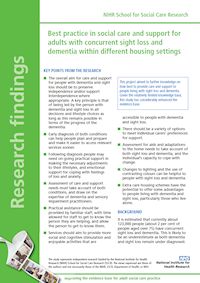What is the best way to support people with sight loss and dementia?
Posted on 16 June 2015

Findings from a two year study into the best practice in social care and support for adults with concurrent sight loss and dementia within different housing settings have been published. It is estimated that currently about 123,000 people (about 2 percent of people aged over 75) have concurrent sight loss and dementia. The project was led by Karen Croucher, in collaboration with the Association for Dementia Studies at Worcester University, Bournemouth University Dementia Institute, and the Cambridge Centre for Housing and Planning Research at Cambridge University.
Meeting the social care and support needs of people with concurrent dementia and sight loss presents complex challenges. However, the policy aspiration to enable a greater proportion of people with complex needs to live and die in their own homes requires the specific challenges of providing care and support for people with concurrent dementia and sight loss to be understood and addressed. Previous research has highlighted a number of factors which limit the effective delivery of social care and support specifically for these people, not least that models of care need to respond to both conditions, rather than working in isolation.
The findings highlight the key principle of being led by the person with dementia and sight loss in all decision and lifestyle choices as long as this remains possible in terms of the progress of the dementia. Changes to lighting, aids and adpatations to the home can ll help to enable the person to remain in familiar surroundings for longer, always bearing in mind the individual's ability to cope with change.
Read the findings here: Research summary (PDF ![]() , 164kb)
, 164kb)
